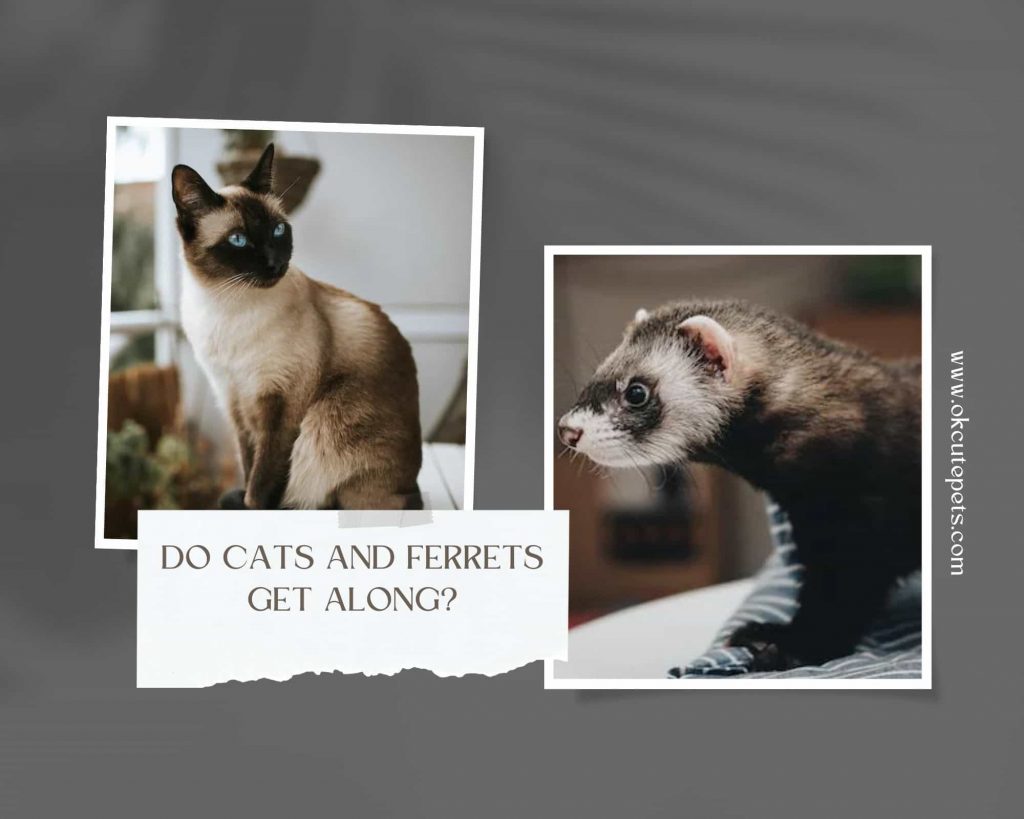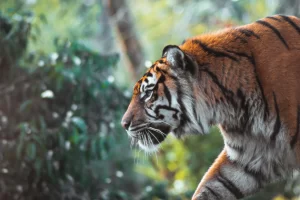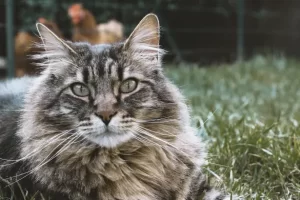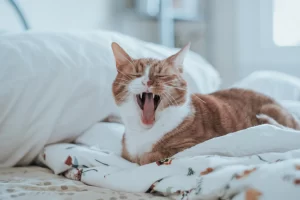
In this article, let’s discuss if cats and ferrets can get along together.
What Is A Ferret?
A ferret is a small, carnivorous mammal belonging to the same family as a weasel. They are very active, playful animals and can make great pets. They are related to polecats and minks and are often kept as indoor pets. They have long, slender bodies and usually require regular grooming and nail clipping.
Cats and ferrets are popular pets with distinct personalities. Many people consider whether cats and ferrets can live together before adopting them. It depends on age, personality type, animal size (a cat is bigger than a ferret), dwelling space, and time for socializing training.
These two animals can get along, but owners may need to work to make these predators comfortable. Introduce your cat or kitten cautiously into any new area where a companionable bond may develop, ideally allowing at least 10-15 minutes apart from periodically monitored meets until trust has been established over several days or weeks.
Although not necessary, it may benefit if either animal has favorable experiences near similar-sized creatures before being introduced. Feather wands and other predatory-themed toys and games can also help. Regular engagement, like caressing or petting while offering treats, builds trust between all parties, which helps create partnerships.
Differences And Similarities Between Cats And Ferrets
Similarities
- Physical Appearance
Both cats and ferrets have similar physical features, including long slender bodies with short legs, large ears that are close to their heads, soft fur coats of various colors and patterns, and bushy tails.
- Intelligence
Both are considered intelligent animals possessing problem-solving skills and can learn commands such as ‘sit’ or ‘stay’ when trained correctly.
- Social Needs
They share many social needs in common; they can be quite playful creatures who enjoy interacting with humans but also crave companionship from other pets like dogs or another cat or ferret companion, which helps keep them socially healthy throughout.
- Activity Level
Cats and Ferrets tend to possess similar levels of energy and activity level, so if you’re looking for an active pet, either one could fit your lifestyle.
- Grooming Needs
Both require regular grooming to stay healthy and look their best. Although the type of fur they have may vary, both need daily brushing or combing since this helps remove dirt, dead hair, or skin cells, as well as any parasites that might be present on the pet’s skin.
Differences
- Size
A cat is generally larger than a ferret and can range in size from 8 to 16 pounds, while ferrets typically weigh between 1-4 lbs. when fully grown.
- Temperament
A Ferret tends to be a very active and playful animal that requires plenty of time outside their cages for exercise, while a cat is more independent creature who prefers sleeping over playing most of the time.
- Lifespan
The average lifespan of a cat is around 15 years. In contrast, a ferret’s life expectancy is only 7-10 years on average due to health issues caused by their small size or other genetic factors specific to them as species.
- Diet/Nutrition Requirements
While both cats and ferrets need things like proteins, fats, carbohydrates, and vitamins; they also have different nutritional requirements with regard to specifically tailored diets designed just for each animal type; one example being how kittens would need higher levels of calcium compared to adult felines but this isn’t necessarily true for young versus mature ferrets which share similar dietary needs regardless age.
- Coat Type and Color Patterns
While there may be some similarities between coat types among various breeds, e.g., long hair vs. short; cats’ coats come in many colors patterns, including solids; allowing individual owners to express themselves through the pet selection process much easier than if they had chosen adopt little ferret whose natural fur patterning is limited mostly to black and white variations.
Benefits Of Having Cats And Ferrets Together
The two can benefit from each other in a variety of ways. Cats are considered independent and solitary creatures, whereas ferrets are naturally social and active. Allowing them to coexist harmoniously creates a happy environment where they may benefit from each other’s companionship.
With their easygoing approach, Cats provide stability for their more lively ferret counterparts, helping to keep their energy levels balanced. Ferrets have an instinctive curiosity that allows them to explore every corner and crevice of your home, stimulating both mentally and physically, something that cats may only sometimes do on their own because they are content doing less activity-based activities such as sleeping or grooming themselves all day. The combination also allows for a lot of fun, whether it’s chasing each other about or simply observing what goes on in daily life at home, which is typically fairly interesting.
Living with two different species gives you twice the love because there will never be a shortage of affectionate embraces from either of the animals. This increases bonding time and promotes healthy development in children, who learn essential lessons about empathy through interactions with these creatures, teaching responsibility while having fun along the way through supervised activities like hide and seek.
How To Train A Cat And A Ferret
Providing plenty of toys and activities for cats and ferrets to keep them entertained, such as scratching posts, interactive cat trees with hiding spots or tunnels, a laser pointer toy you can control from your phone or laptop, treat dispensers that require problem-solving skills to receive treats like puzzle feeders.
Establish routines around meal times, so they know when food will be available; this helps create positive associations between training sessions and meals while also preventing overfeeding, which can lead to obesity. Ensure the area is safe during playtime by removing dangerous objects like strings or cords that could entangle paws, tails, or necks and sharp edges on furniture corners – both species love exploring!
Use reward-based methods rather than scolding: for cats, use verbal cues & praise along with small rewards like kibble pieces every time he does what’s asked correctly; Ferrets respond better if rewarded immediately after performing desired behaviors using high-value treats such as cooked chicken bits – make sure not too much fat content though!
Start teaching basic commands like “come,” “sit,” and “stay” combined with hand signals and gestures whenever possible – repetition and consistency are key factors here but don’t forget lots of patience and encouragement throughout all stages, especially when introducing new tricks; Keep the session short yet fun.
Schedule regular vet visits once per year at a minimum: Healthy animals learn faster because their bodies have enough energy reserves, which allows veterinarian checkups before health problems arise unexpectedly due to long-term neglect.
Appropriate Toys For Cats And Ferrets
- Catnip-filled Toys
These two loves to play with catnip toys, which can help keep them mentally and physically stimulated.
- Climbing Trees or Posts
Both of them enjoy climbing trees or posts to exercise their muscles, stretch their bodies, and satisfy their natural exploration instinct.
- Interactive Puzzle Toys
Interacting puzzle toys are ideal for both types of animals since they offer an outlet for mental stimulation while providing physical activity opportunities through manipulating pieces within the toy.
- Exercising Balls
Exercise balls provide a fun way for your pet to get some much-needed physical activity indoors without having access to outside space; perfect if you don’t have room or time for outdoor activities like running around or playing fetch games with your furry friend.
Nutrition For A Cat And A Ferret
These two animals need nutritional meals to be healthy and active. Cats are obligate carnivores and must eat animal proteins. Although carnivorous, ferrets can digest some plant-based proteins. High-protein, low-carb diets fulfill cats’ and ferrets’ nutritional needs.
Taurine, an amino acid necessary for heart, eyesight, and reproductive health, are needed in cats’ diets. Taurine is in fish, chicken, and meat. Ferrets need Omega-6 fatty acid-rich diets. These acids support immune, skin, and reproductive health.
Vitamin and mineral-rich meals are also necessary for a cat and a ferret. Vitamins and minerals help the two grow and stay healthy. Vitamins A, D, E, and K are crucial for cats and ferrets. They need vitamins C and B, but they can create them themselves. They need low-fat, high-moisture diets. Weight gain and dehydration can result from high-fat and low-moisture diets. They should be fed a mix of proteins, fruits, and vegetables to ensure a healthy diet.
Challenges Of Keeping Cats And Ferrets Together
- Territorial Issues
Both are territorial animals and may not always get along with other animals. If a ferret is aggressive towards a cat, the cat may respond defensively and may even attack the ferret. To prevent harm, closely monitoring the interactions between a cat and a ferret is important.
- Incompatibility
A cat and a ferret have different temperaments and energy levels, which can make them incompatible. Cats are typically more laid back and less active than ferrets, so they may only sometimes get along.
- Health Issues
Cats and ferrets can carry various diseases and parasites that can be passed between them. These include fleas, ticks, and mites. It is important to ensure both animals are healthy and up to date on their vaccinations before introducing them to each other.
- Safety
Cats and ferrets can be curious and explore unsafe areas. It is important to ensure the space they are in is safe and secure, as they may get into things that can harm them.
- Space
They both need their own space and require different types of environments. Cats need a place to climb, hide, and scratch, while ferrets need a space to explore and play. It is important to provide both of them with their areas to ensure they have enough space to be comfortable.
Signs Of Stress In Cats And Ferrets
Signs of stress in cats and ferrets can vary depending on the individual animal, but some common signs to look out for include the following:
- Changes in behavior. They may become more aggressive, withdrawn, or clingy when stressed. They may also exhibit anxiety, such as pacing, excessive grooming, or hiding.
- Changes in appetite. They may lose their appetite when stressed.
- Changes in sleeping patterns. They may sleep more or less than usual when stressed.
- Changes in vocalizations. These two may meow or chirp more than usual when stressed.
- Changes in body language. The two may show signs of stress through their body language, such as dilated pupils, flattened ears, or a tucked tail.
Pay attention to any changes in your cat or ferret’s behavior and take steps to reduce their stress levels if necessary.
Conclusion
Cats and ferrets can get along, but it is important to remember that they are two very different animals with different needs. Cats are solitary animals and may not appreciate the attention and energy of a ferret. On the other hand, ferrets are social animals and may become bored or frustrated if not given enough attention. It is important to provide both animals with plenty of space and enrichment to keep them both happy and healthy. With patience and understanding, they can learn to coexist peacefully and even become friends.


